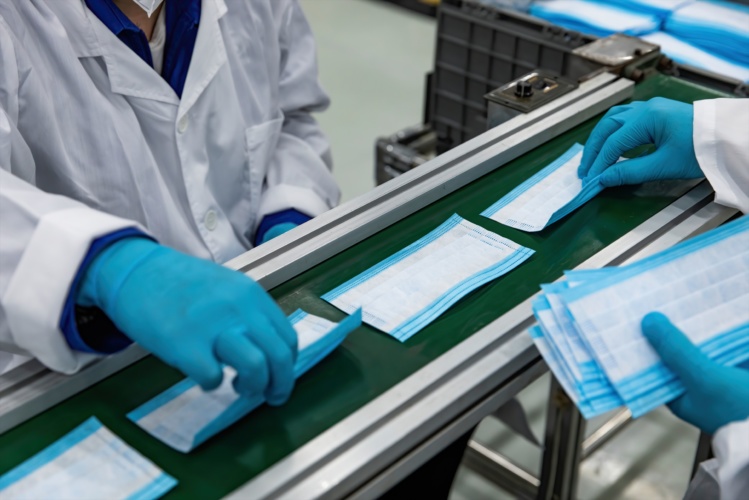Let's imagine a fully automated production line, able to meet the demands of medical supplies, pharmaceuticals, food and other products necessary to maintain the basic lifestyle of our modern society.
As input, we only supply energy and the raw materials. As output, we will have final goods. Imagine being able to control such a facility remotely, without the need for humans on the shop floor. And if we could ensure self-maintenance and easy production line reconfiguration, wouldn't that solve some of the problems we are experiencing today, due to the coronavirus crisis?
The answer to this question is simple. Yes, it would. A more complicated question, however, is whether something like that is practical today or whether it is still far in the future – or even pure fantasy. Other questions we might ask are: how much would such a solution cost? And under what conditions would it pay itself back?
Today, there are already several fully automated production facilities around the world, facilities where production is still taking place under the supervision of operators but otherwise without any manual operation. These are, however, mostly small-scale, single-purpose plants. We can also find fully automated warehouses, where all the work is being done by robots and autonomous transporters. But there is not a single known example that meets the idea we outlined above – a fully automated and flexible plant.

Prerequisites for fully automated production
To be able to even think of fully automated production, it is necessary to put some key technologies and procedures into practice. These include:
- Open integration standards – Fully automated production requires the integration of production components from various suppliers. Therefore, it is necessary to ensure their easy interconnectivity and interoperability.
- Autonomy and cooperation – Autonomy, in the context of fully automated production, means that some components will be fully responsible for all aspects of the operation, including dealing with non-standard situations. At the same time, it is necessary to ensure that such autonomous components cooperate with each other to reach the overall production goals together.
- Self-maintenance and redundancy – A fully automated production system needs the ability to solve any faults and outages of production components quickly to prevent the shutdown of the entire plant. This can be done in several ways: the production unit could be able to repair or recover itself, for instance; or it could use redundancy – where the faulty unit is replaced by another that automatically takes over the task.
- Simple reconfigurability – The design of such a plant must allow for flexible changes to the production program, as well as to the production volume itself. This allows quick adjustment of production in critical situations, and guarantees a return on the investment made to fully automated production.
- Artificial Intelligence and Machine Learning algorithms – These algorithms can help address the autonomy, cooperation and self-recovery needs mentioned above. But they also help with planning, optimisation and increasing the efficiency of the production process.
We can see many of these technologies in modern facilities today, and their use is increasing. However, they are not yet being used to their full potential. A potential that would allow for fully autonomous operation without huge investments.
Let’s explore some of the other advantages fully automated production could bring.
Not just fast, flexible production
In addition to the obvious advantages of automated production – accuracy, repeatability and speed – autonomous plants also provide significantly lower dependence on human labour. This is a crucial benefit of automation. The availability of a sufficient workforce is a long-term problem. We were dealing with it before the coronavirus pandemic, and we are now dealing with it as it runs its course.
Fully automated plants also bring significant benefits beyond the crisis period. For instance, in handling hazardous materials; or when complying with extreme sterility or accuracy requirements.
Other benefits are less obvious – however, they are no less important. In a full-automation scenario, with no workers on site, strict safety rules are no longer necessary. Machines can work more quickly than their human counterparts, and with a smaller footprint. And plant floors don’t have to be heated, air-conditioned or provided with overall lighting – unless the production technology requires that.
READ MORE ABOUT THE ENGINEERING RESPONSE TO COVID-19
As you can see, fully automated production solves many problems that we’re faced with today. And it also offers a range of other benefits. So why aren’t there more such plants today? The major obstacle to global deployment is the total cost of ownership and the complexity of the overall solution. It also requires a society-wide shift in workforce qualification. And a change of management approach in different industry verticals.
Autonomous plants as part of the critical infrastructure
The current pandemic could prove to be a strong motivator in the development of more fully automated solutions, resolving some of the key problems facing us today. Fully automated production facilities could be a key part of a country’s critical infrastructure. They could prove invaluable in provisioning food, pharmaceuticals and other products that are currently vitally needed.
It may be that, once the current crisis is over, we will be witnesses to a societal debate on the need for better preparation for similar situations in the future. Preparations that could well include the deployment of more complete automation.
Visit Rockwell Automation's website to find out more about fully automated production and the Connected Enterprise.










Water Sector Talent Exodus Could Cripple The Sector
Maybe if things are essential for the running of a country and we want to pay a fair price we should be running these utilities on a not for profit...